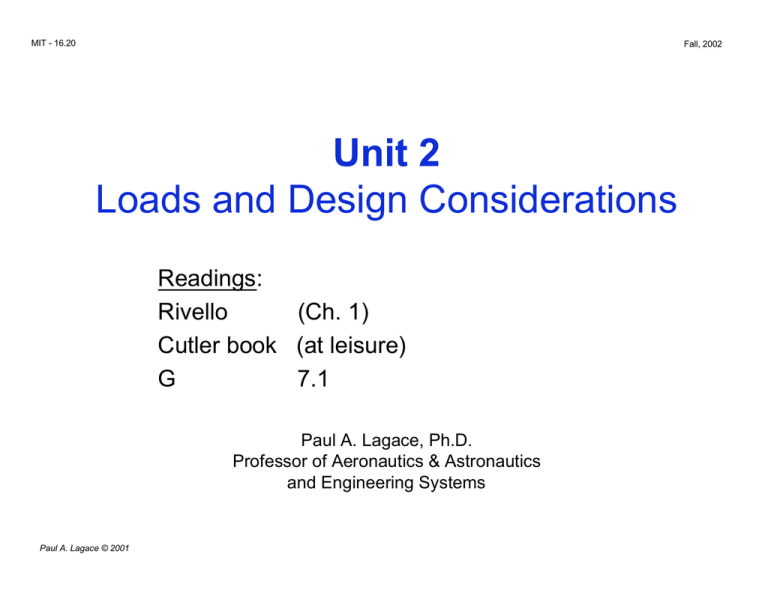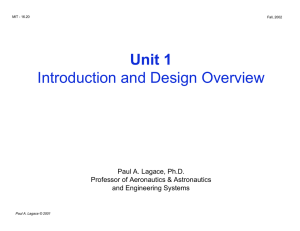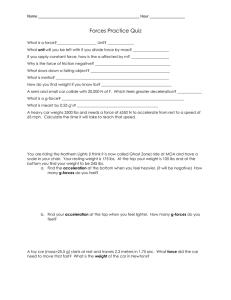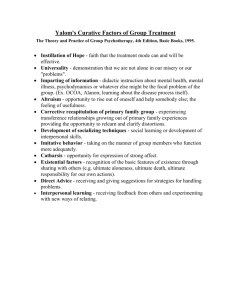Document 13475850
advertisement

MIT - 16.20 Fall, 2002 Unit 2 Loads and Design Considerations Readings: Rivello (Ch. 1) Cutler book (at leisure) G 7.1 Paul A. Lagace, Ph.D. Professor of Aeronautics & Astronautics and Engineering Systems Paul A. Lagace © 2001 MIT - 16.20 Fall, 2002 Sources of Stresses and Strains Depends on type of structure Aircraft General Paul A. Lagace © 2001 Launch Vehicles Space Structures Other Considerations Unit 2 - p. 2 MIT - 16.20 Fall, 2002 Can generally divide these into: • Normal operational effects (regular use) • Environmental effects (internal stresses, material property degradation) • Isolated effects (lightning, impact) In a (large company) • “Design” group does general management • “Loads” group determines operating conditions • This is passed on to “stress” group that analyzes stresses and deformations • “Materials” group provides material ultimates, etc. ⇒ Need to understand each part NOTE: New approach in companies: IPT (Integrated Product Teams) DBT (Design Build Teams) - people from each branch including manufacturing and marketing ⇒ even more important to understand various factors Paul A. Lagace © 2001 Unit 2 - p. 3 MIT - 16.20 Fall, 2002 Factors, Margins, etc. Two important definitions for static considerations Limit Load/Stress/Condition: Maximum load/stress/condition where structure shows no permanent deformation. Ultimate Load/Stress/Condition: Maximum load/stress/condition where structure does not “fail.” Definition is key; often defined as “break” (i.e., carry no more load) Operationally, the limit load is the maximum load the structure is expected to see The ultimate load provides a “factor of safety” for unknowns Ultimate Factor of Safety (U.F.S.) = Ultimate Load Limit Load This is a design value Paul A. Lagace © 2001 Unit 2 - p. 4 MIT - 16.20 Fall, 2002 F.O.S. is also a “Factor of Ignorance” This accounts for Æ probability & statistics (also in material allowances) U.F.S. = 1.5 for Aircraft 1.25 for Spacecraft (unmanned) Design is usually conservative and an additional “Margin of Safety” (M.O.S.) is used/results Limit MOS = Tested Limit X - Limit X Limit X Ultimate MOS = Tested Ultimate X - Ultimate X Ultimate X An MOS is an experimental reality. Paul A. Lagace © 2001 Unit 2 - p. 5 MIT - 16.20 Fall, 2002 Try to minimize M.O.S. - Too conservative ⇒ too heavy - Not conservative enough ⇒ plane falls out of sky (things have flown with negative M.O.S.) So, begin with “operational envelope”, the way the structure will be used • Aircraft --> v-n diagram • Spacecraft, etc. Then add special conditions (gusts, etc.) Also need to account for • Environmental effects - change in material properties - causes stresses and strains • Special conditions - Lightning - Impact - etc. Paul A. Lagace © 2001 Unit 2 - p. 6 MIT - 16.20 Fall, 2002 • Fatigue (cyclic loading) - Effect on material properties - Damage growth Example A fighter aircraft has a gross take-off weight of 30,000 lbs. In a test of one wing, the wing fails at a total loading of 243,000 lbs. What is the margin of safety? Definition of M.O.S. = Tested Ultimate - Ultimate Ultimate We know: Tested Ultimate = 243,000 lbs. (for one wing) How do we get the Design Ultimate? Design Ultimate = Design Limit x Factor of Safety For aircraft, F.O.S. = 1.5 Paul A. Lagace © 2001 Unit 2 - p. 7 MIT - 16.20 Fall, 2002 How do we get the Design Limit? Use the v-n diagram From U.E., max n for fighter = 9 = limit n (Note: n for level flight = 1 ⇒ loading for level flight = weight) ⇒ Design Limit = nlimit x weight = 9 x 30,000 lbs. = 270,000 lbs. But, each wing carries 1/2 of this Design limit load for one wing = 135,000 lbs. ⇒ Design ultimate load for one wing = 202,500 lbs. Finally, M.O.S. = 243,000 lbs. - 202,500 lbs. 202,500 lbs. = 40,500 lbs. = 202,500 lbs. 0.2 = M.O.S + 20% margin Paul A. Lagace © 2001 Unit 2 - p. 8 MIT - 16.20 Fall, 2002 What is “failure”? It depends on use…. ….may be deflection based (CTE example) ….may be fracture ….may be buckling . . . Overall, you must consider: Static Stresses - Fracture - Yielding - Buckling Deflections - Clearances - Flutter - Vibration - Tolerances (e.g., C. T. E.) Paul A. Lagace © 2001 Unit 2 - p. 9 MIT - 16.20 Fall, 2002 Life - Damage accumulation “Fatigue” For aircraft, design guidelines provided by FAA F.A.R.’s (Federal Aviation Regulations) Part 23 Part 25 Aircraft Under 14,000 lbs. Aircraft Above 14,000 lbs. Part 27 Part 29 Helicopter USAF guidelines (e.g., Damage Tolerance Regulations) Paul A. Lagace © 2001 Unit 2 - p. 10




